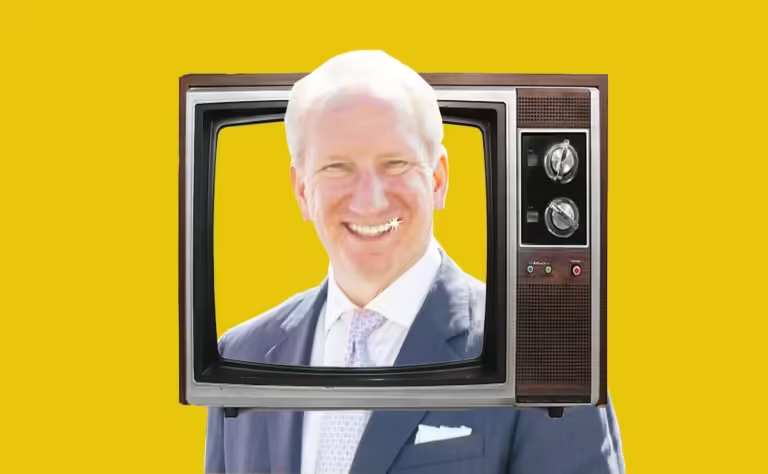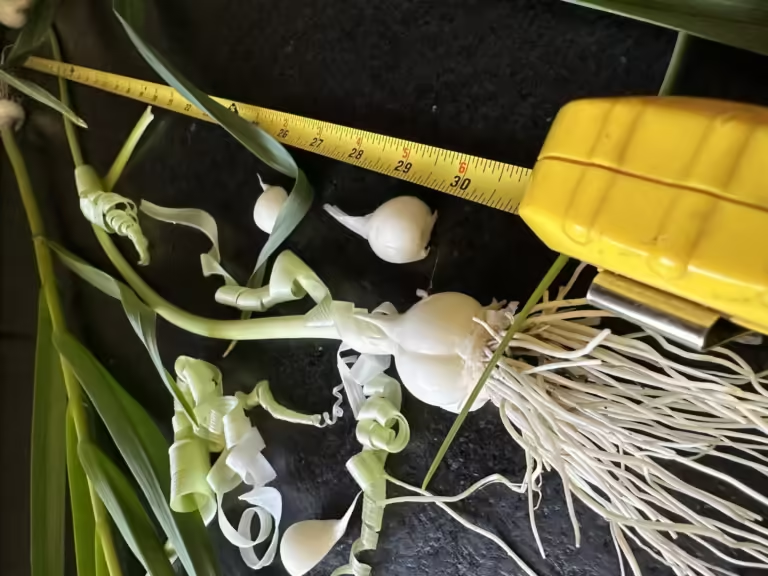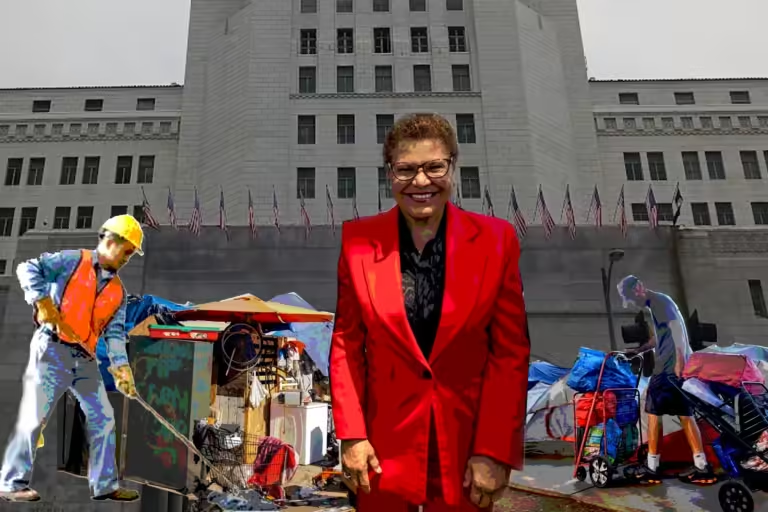LA Confronts Homelessness As Its Most Daunting Olympic Challenge
“Whatever you did for one of the least of these brothers and sisters of mine, you did for me.” — Matthew 25:40
As Los Angeles prepares to host its third Olympic Games, an urgent question has emerged: Will it finally confront and solve its homelessness problem? LA’s first Olympics, in 1932, came amid the Great Depression, when millions were homeless nationwide, with many living in shantytowns called “Hoovervilles.” There was nothing particularly special about LA then. But LA’s second Olympics, in 1984, came at a time when the Department of Housing and Urban Development dubbed LA County “the homeless capital of America” — and the problem only got worse in the years that followed.
And now that same challenge is facing Mayor Karen Bass, who, to her credit, actually regards it as a problem to be solved, and sees homeless individuals as members of the community, reflecting societal failures that it’s her job to help overcome. In March, after visiting France as part of a preparatory Olympic delegation, Bass told KCRW, “I am hopeful … that the LA Olympics will help be a catalyst to LA finally addressing homelessness in a way that is long-term, that eventually ends street homelessness.” In an Aug. 12 press release summing up her Olympic trip, she included “confronting the homelessness crisis with the urgency it requires” as part of her focus “to create lasting impacts in L.A. for generations to come.”
But just two days after that, Human Rights Watch released a scathing report, “‘You Have to Move!’ The Cruel and Ineffective Criminalization of Unhoused People in Los Angeles,” which built on the foundation that “International human rights law upholds a right to housing for everyone.” Bass herself is a critic of criminalization, and the report noted the changes she has initiated. But it called her signature program, Inside Safe, “unsustainably expensive, plagued by inconsistent and inadequate support services, and stymied by the lack of permanent housing for people to move on to,” and noting its lack of capacity: “only 1,500 rooms at its peak” compared to “over 35,000 people living without shelter on the streets of Los Angeles.”
Before entering politics, Bass was a healthcare worker who also worked in psychiatric emergency rooms, so she’s acting in part from front-line experience and is well aware that “It costs way more to incarcerate somebody than it does to take care of them,” she told KCRW.
And so, on Sept. 5, the Economic Roundtable stepped in to propose how to close the gap between Bass’ stated intentions and her record so far, with a report “Excelling for the 2028 Olympics: Restoring, Not Displacing, LA’s Unsheltered Residents” that includes a 10-item list of “specific actions that will make Los Angeles a credible host for the 2028 Olympic Games.” The report takes a systemic approach that treats the unhoused with dignity, with a focus on proactive interventions to reduce long-term costs and consequences.
“It’s hard for cities not to treat the Olympics like a beauty contest” with “the best specimens of humanity coming together to compete to excel,” the report’s lead author, Daniel Flaming, president of the Economic Roundtable, told Random Lengths. “A tawdry backdrop for all of that is embarrassing.” LA isn’t the first Olympic host city facing this. But, “Our history is Tinseltown in movies and illusions,” he noted, “so how do we present ourselves credibly when we have this glaring, painful problem of a heck of a lot of street homeless?”
“I agree with what Mayor Bass has said, that the Olympics are an opportunity to do something different and better,” said co-author Gary Blasi, a UCLA Law Professor Emeritus. “But that’s about as far as the conversation from the local political establishment has come,” he noted. “If there is a plan to make things proceed at a better pace, to get us in a position to have many fewer people living outdoors in terrible circumstances, nobody’s seen that plan.” As things stand, “We’re on a collision course with truly catastrophic public relations nightmare and/or human rights crisis and we have four years to deal with it,” he concluded.
“Housing is a policy choice,” stressed a third co-author, Anthony Orlando, a real estate economist at Cal State Pomona. “The type of housing system that each city has is a social decision. We sometimes act like this is everybody … making their own individual decisions, but we create a housing system,” he said. “We make a decision as a society how we want to look, and one of the biggest correlates with homelessness rates across the United States is housing affordability. If you don’t have enough affordable housing, that’s one of the best predictors of how much homelessness you’ll have.”
Other factors are secondary, if not irrelevant. “It’s not how much drug abuse there is, or mental health, mental illness rates or anything like that,” he stressed. “Housing affordability is the number one predictor, and so the mayor has a lot of influence over how much affordable housing we build. They can’t do it by themselves,” he acknowledged. “But cities like Los Angeles haven’t been able to keep up with the rising cost of housing and so I think that’s the first policy lever that you would naturally try to pull on.”
However, addressing affordability takes time, and a systemic problem needs multiple different solutions to be brought to bear. Given the current affordability problem, it’s not surprising that the first two recommendations presented echo key themes of the Roundtable’s recent report “The Work Behind Work” — the importance of adequate income and early intervention:
- Address homelessness as a problem of inadequate income by providing help in getting a job or providing a basic income.
- Increase early exits from homelessness through interventions that result in stable housing. This includes using predictive screening tools that accurately identify individuals who are likely to be persistently homeless so that they can be helped before, or soon after, they become homeless rather than after long-term harm has accumulated in their lives.
Citing data from annual homeless surveys, Flaming stressed, “The overriding problem is people don’t have money, and a lot of people, particularly the newly homeless people, younger people, parents with kids, really want to work. A few of them had a job — maybe temporary, maybe seasonal, a little bit of work — but mostly they’re out there trying to find a job,” he said. “And so that’s the piece that I think shows up in the recommendation several times.”
What’s more, “For a chunk of folks helping them get better skills, helping them stabilize their lives, getting their feet on solid ground and getting into a job is one of the cheaper and more dignified solutions for getting out of [being] homeless and not being homeless again.”
Blasi noted a related problem: In LA County, the basic state-mandated grant for people who can’t find a job or have a disability that’s not severe enough to qualify for Social Security disability, hasn’t changed from $221/month in 40 years, while housing costs have more than quadrupled. When he first began working on homeless issues in 1984, “On skid row, you could get a room sometimes for 50 bucks a week, so you were running on the knife edge, being literally on the street, but you had some choices,” he said. “Had it kept pace with the cost of housing, it would be $1,008.” That it hasn’t is “completely a decision that’s up to the County Board of Supervisors.”
The third recommendation is “Provide incentives to make affordable space in the existing housing stock, particularly the informal housing stock, available for unsheltered individuals.”
The problem is twofold, Blasi said. First, “People don’t have very good access to knowing where that is, other than through their social networks,” but more importantly, the government can play a role. “There are still a significant number of single-family homeowners who are extremely poor and could use some income, and if they knew how to go about it, and how to screen, and how to potentially pair up with somebody they would find welcome in their home, that would help solve a problem that right now nobody addresses directly,” he said.
The report also suggests “the City and County could develop incentives for those who potentially have space to rent,” and “giving basic income subsidies to unhoused people to help pay for it.”
The fourth recommendation is “Extend restorative interventions to couch-homeless individuals who need employment or basic income interventions that will enable them to pay rent and have a claim to housing.”
“Couch homeless” means “somebody who’s couch surfing and not paying anything for rent,” Flaming explained. “We estimate that for every person who meets HUD’s definition, which is sleeping in a place not meant for human habitation, or being in a shelter, that there [are] another 1.8 people who are couch homeless,” which means — once again — that the problem is bigger than it superficially appears, and that an even more robust response is needed.
The fifth recommendation is “Increase the supply of affordable housing,” which is both obvious and fundamental, but “We’ve actually had a deceleration in building new housing in the LA region,” Flaming noted. “The supply side isn’t headed in the right direction.” The report notes that while LA County has the highest rate of homelessness, it doesn’t have the highest poverty or unemployment rate, but what it “does have is high housing prices and high inequality.” If Kamala Harris is elected, and her affordable housing initiative goes forward, that will certainly help. But local efforts will be needed as well.
New technologies can also help. Blasi cited the example of “roto-molded plastic modules that were originally created to provide shelter for people in flood catastrophes,” which are far less expensive to build than traditional housing. “I went to see an operation like this in El Monte and it was really impressive,” he said. Manufacturing processes — currently limited to “theoretically towable mobile homes,” could be employed more broadly.
The sixth recommendation is to “Protect renters from unjust evictions by requiring landlords to have just cause to terminate a tenant’s lease and by ensuring the right to legal counsel.” The report notes that “In the most comprehensive economic analysis of evictions to date, researchers showed that a judge’s eviction order has such a damaging effect on income, indebtedness, credit scores, access to credit, and health that it significantly increases the likelihood that a family will become homeless.” It’s an example of how quickly systemic costs mushroom with little notice when they’re borne by those with the least power in society.
A prospective state law can help, Blasi noted. “The legislature just passed a bill giving tenants 10 days to respond to an eviction case instead of the current five, which was the shortest in the United States, we’re tied with Florida and worse than Georgia and Texas,” he said. But adequate legal assistance, and educating judges about the above-noted consequences are urgently needed as well.
The seventh recommendation is “Prevent homelessness through jail and shelter diversion, emergency rent assistance, landlord conflict mitigation, and income support.”
This relates to the previous recommendation but places it in the larger context of difficult life trajectories leading to homelessness. So it’s important “to try to at different stages in the process to prevent the problems from getting worse,” Flaming said — “to divert people from jails into shelters, to help with emergency rental assistance rather than letting people get evicted, to mediate with their landlord if they’re in some sort of spat with their landlord or getting them caught up on rents… but also just through income support as we described.”
The eighth recommendation is “Expand record expungement programs, especially for crimes related to homelessness and poverty. Complement law enforcement interventions with the engagement of housing providers, health, mental health and substance abuse services, community colleges, and case managers who provide whole-person support.”
This goes directly to points made in the Human Rights Watch report, Blasi pointed out. “They found that 38% of all the citations and arrests that LAPD did between 2016 and 2022, were homeless people, which is a ridiculous proportion of arrests being focused on unhoused people,” who make up only 1% of the population. And when it comes to violations of park regulations, 100% of the 12,427 arrests recorded were of unhoused people. “Most were for infractions, but almost one-third were misdemeanors,” the HRW report noted.
The ninth recommendation is “Enact and enforce labor laws that protect employed workers, ensure payment of living wages, and require fair scheduling.”
“One of the causes of homelessness is people being low-paid, on-demand workers,” Flaming explained. “You don’t have full-time hours, you don’t get paid that much for when you do work, and you don’t know when you’re gonna work so it’s hard to hold down a second job.” Which is why the whole package of worker protections is needed.
The tenth recommendation is to “Help newly housed individuals to overcome their isolation through service components that build friendships and community ties.”
Deteriorating social relations are repeatedly reported by the unhoused, Flaming noted. So it’s vital “to help people build positive social networks with friends, with allies, with neighbors and to not be isolated and cut off, to be part of the social fabric.”
“One of the things that Bass did right in my view was move all encampments together,” Blasi chimed in. “People are social creatures… you put them all together in a place for a time, they will begin to act together. There’ve been some impressively organized encampments with a lot of mutual aid, and self-help. And the traditional system of dealing with people individually is you take somebody out of an encampment, and send them far away from anybody they know, so it isolates people. So doing this in a way that builds on the strengths of what people have, including maintaining those links, and I think is a good thing.”
It’s obvious from this landscape of options that there’s a great deal that can be done. So what stands in the way of doing it?
“It’s a misperception about who’s unhoused. It’s a misperception about the fundamental fact that they’re equal human beings with just as much dignity as the rest of us, just as much desire to have shelter as the rest of us,” Orlando said. “The stigma attached to homelessness is extraordinary. You walk through Los Angeles and talk to housed people and get their impressions of the unhoused population and it’s nowhere near accurate. Trying to overcome that perception is fundamental to allowing elected officials to make policy change.”
“Somehow in some people’s minds — apparently including [Gov. Gavin] Newsom’s, there is the idea of homelessness is bad behavior and you can punish people out of it, but you can’t really punish people out of poverty,” Flaming said. “It’s a problem you have to solve, and you solve it through empowerment and through restoration and through dealing with trauma. You don’t solve it by beating people up more.”






 He and his group of concerned parents said they met with the Dean of students at Carson High School and the Los Angeles County Sheriff’s Department. Both have launched an investigation.
He and his group of concerned parents said they met with the Dean of students at Carson High School and the Los Angeles County Sheriff’s Department. Both have launched an investigation.









